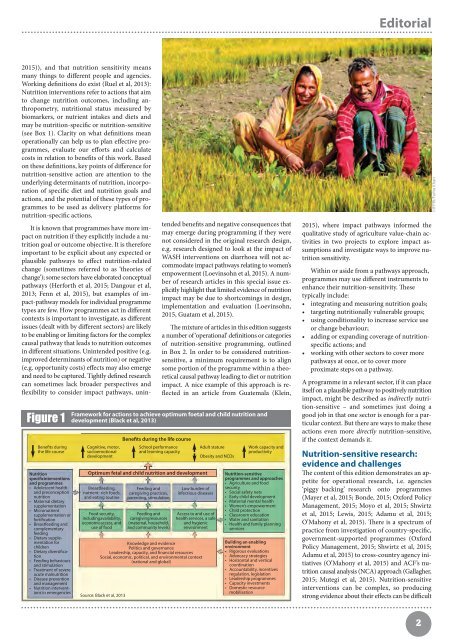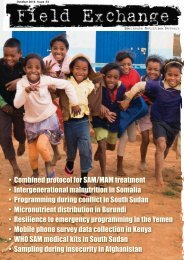Special focus on nutrition-sensitive programming
21dWhgZ
21dWhgZ
Create successful ePaper yourself
Turn your PDF publications into a flip-book with our unique Google optimized e-Paper software.
Editorial<br />
. . . . . . . . . . . . . . . . . . . . . . . . . . . . . . . . . . . . . . . . . . . . . . . . . . . . . . . . . . . . . . . . . . . . . . . . . . . . . . . . . . . . . . . . . . . . . . . . . . . . . . . . . . . . . . . . . . . . . . . . . . . . . . . . . . . . . . .<br />
2015)), and that nutriti<strong>on</strong> sensitivity means<br />
many things to different people and agencies.<br />
Working definiti<strong>on</strong>s do exist (Ruel et al, 2013):<br />
Nutriti<strong>on</strong> interventi<strong>on</strong>s refer to acti<strong>on</strong>s that aim<br />
to change nutriti<strong>on</strong> outcomes, including anthropometry,<br />
nutriti<strong>on</strong>al status measured by<br />
biomarkers, or nutrient intakes and diets and<br />
may be nutriti<strong>on</strong>-specific or nutriti<strong>on</strong>-<strong>sensitive</strong><br />
(see Box 1). Clarity <strong>on</strong> what definiti<strong>on</strong>s mean<br />
operati<strong>on</strong>ally can help us to plan effective programmes,<br />
evaluate our efforts and calculate<br />
costs in relati<strong>on</strong> to benefits of this work. Based<br />
<strong>on</strong> these definiti<strong>on</strong>s, key points of difference for<br />
nutriti<strong>on</strong>-<strong>sensitive</strong> acti<strong>on</strong> are attenti<strong>on</strong> to the<br />
underlying determinants of nutriti<strong>on</strong>, incorporati<strong>on</strong><br />
of specific diet and nutriti<strong>on</strong> goals and<br />
acti<strong>on</strong>s, and the potential of these types of programmes<br />
to be used as delivery platforms for<br />
nutriti<strong>on</strong>-specific acti<strong>on</strong>s.<br />
It is known that programmes have more impact<br />
<strong>on</strong> nutriti<strong>on</strong> if they explicitly include a nutriti<strong>on</strong><br />
goal or outcome objective. It is therefore<br />
important to be explicit about any expected or<br />
plausible pathways to effect nutriti<strong>on</strong>-related<br />
change (sometimes referred to as ‘theories of<br />
change’); some sectors have elaborated c<strong>on</strong>ceptual<br />
pathways (Herforth et al, 2015; Dangour et al,<br />
2013; Fenn et al, 2015), but examples of impact-pathway<br />
models for individual programme<br />
types are few. How programmes act in different<br />
c<strong>on</strong>texts is important to investigate, as different<br />
issues (dealt with by different sectors) are likely<br />
to be enabling or limiting factors for the complex<br />
causal pathway that leads to nutriti<strong>on</strong> outcomes<br />
in different situati<strong>on</strong>s. Unintended positive (e.g.<br />
improved determinants of nutriti<strong>on</strong>) or negative<br />
(e.g. opportunity costs) effects may also emerge<br />
and need to be captured. Tightly defined research<br />
can sometimes lack broader perspectives and<br />
flexibility to c<strong>on</strong>sider impact pathways, unin-<br />
Figure 1<br />
Benefits during<br />
the life course<br />
Cognitive, motor,<br />
socioemoti<strong>on</strong>al<br />
development<br />
Benefits during the life course<br />
tended benefits and negative c<strong>on</strong>sequences that<br />
may emerge during <strong>programming</strong> if they were<br />
not c<strong>on</strong>sidered in the original research design,<br />
e.g. research designed to look at the impact of<br />
WASH interventi<strong>on</strong>s <strong>on</strong> diarrhoea will not accommodate<br />
impact pathways relating to women’s<br />
empowerment (Loevinsohn et al, 2015). A number<br />
of research articles in this special issue explicitly<br />
highlight that limited evidence of nutriti<strong>on</strong><br />
impact may be due to shortcomings in design,<br />
implementati<strong>on</strong> and evaluati<strong>on</strong> (Loevinsohn,<br />
2015, Guatam et al, 2015).<br />
e mixture of articles in this editi<strong>on</strong> suggests<br />
a number of ‘operati<strong>on</strong>al’ definiti<strong>on</strong>s or categories<br />
of nutriti<strong>on</strong>-<strong>sensitive</strong> <strong>programming</strong>, outlined<br />
in Box 2. In order to be c<strong>on</strong>sidered nutriti<strong>on</strong><strong>sensitive</strong>,<br />
a minimum requirement is to align<br />
some porti<strong>on</strong> of the programme within a theoretical<br />
causal pathway leading to diet or nutriti<strong>on</strong><br />
impact. A nice example of this approach is reflected<br />
in an article from Guatemala (Klein,<br />
Framework for acti<strong>on</strong>s to achieve optimum foetal and child nutriti<strong>on</strong> and<br />
development (Black et al, 2013)<br />
2015), where impact pathways informed the<br />
qualitative study of agriculture value-chain activities<br />
in two projects to explore impact assumpti<strong>on</strong>s<br />
and investigate ways to improve nutriti<strong>on</strong><br />
sensitivity.<br />
Within or aside from a pathways approach,<br />
programmes may use different instruments to<br />
enhance their nutriti<strong>on</strong>-sensitivity. ese<br />
typically include:<br />
• integrating and measuring nutriti<strong>on</strong> goals;<br />
• targeting nutriti<strong>on</strong>ally vulnerable groups;<br />
• using c<strong>on</strong>diti<strong>on</strong>ality to increase service use<br />
or change behaviour;<br />
• adding or expanding coverage of nutriti<strong>on</strong>specific<br />
acti<strong>on</strong>s; and<br />
• working with other sectors to cover more<br />
pathways at <strong>on</strong>ce, or to cover more<br />
proximate steps <strong>on</strong> a pathway.<br />
A programme in a relevant sector, if it can place<br />
itself <strong>on</strong> a plausible pathway to positively nutriti<strong>on</strong><br />
impact, might be described as indirectly nutriti<strong>on</strong>-<strong>sensitive</strong><br />
– and sometimes just doing a<br />
good job in that <strong>on</strong>e sector is enough for a particular<br />
c<strong>on</strong>text. But there are ways to make these<br />
acti<strong>on</strong>s even more directly nutriti<strong>on</strong>-<strong>sensitive</strong>,<br />
if the c<strong>on</strong>text demands it.<br />
Obesity and NCDs<br />
Nutriti<strong>on</strong>-<strong>sensitive</strong> research:<br />
evidence and challenges<br />
Nutriti<strong>on</strong><br />
Optimum fetal and child nutriti<strong>on</strong> and development Nutriti<strong>on</strong>-<strong>sensitive</strong><br />
e c<strong>on</strong>tent of this editi<strong>on</strong> dem<strong>on</strong>strates an appetite<br />
for operati<strong>on</strong>al research, i.e. agencies<br />
specificinterventi<strong>on</strong>s<br />
programmes and approaches<br />
and programmes<br />
• Agriculture and food<br />
• Adolescent health<br />
Feeding and<br />
Low burden of security<br />
‘piggy backing’ research <strong>on</strong>to programmes<br />
and prec<strong>on</strong>cepti<strong>on</strong><br />
caregiving practices, infectious diseases • Social safety nets<br />
nutriti<strong>on</strong><br />
parenting, stimulati<strong>on</strong><br />
• Early child development (Mayer et al, 2015; B<strong>on</strong>de, 2015; Oxford Policy<br />
• Maternal dietary<br />
• Maternal mental health<br />
supplementati<strong>on</strong><br />
• Women’s empowerment Management, 2015; Moyo et al, 2015; Shwirtz<br />
• Micr<strong>on</strong>utrient<br />
• Child protecti<strong>on</strong><br />
supplementati<strong>on</strong> or Food security,<br />
Feeding and Access to and use of • Classroom educati<strong>on</strong><br />
et al, 2015; Lewis, 2015; Adamu et al, 2015;<br />
fortificati<strong>on</strong><br />
includingavailability, caregivingresources health services, a safe • Water and sanitati<strong>on</strong><br />
• Breastfeeding and ec<strong>on</strong>omicaccess, and (maternal, household, and hygienic • Health and family planning O’Mah<strong>on</strong>y et al, 2015). ere is a spectrum of<br />
complementary<br />
use of food and community levels) envir<strong>on</strong>ment<br />
services<br />
practice from investigati<strong>on</strong> of country-specific,<br />
feeding<br />
• Dietary supple-<br />
government-supported programmes (Oxford<br />
mentati<strong>on</strong> for<br />
Knowledge and evidence<br />
Building an enabling<br />
children<br />
Politics and governance<br />
envir<strong>on</strong>ment<br />
Policy Management, 2015; Shwirtz et al, 2015;<br />
• Dietary diversifica-<br />
Leadership, capacity, and financial resources<br />
• Rigorous evaluati<strong>on</strong>s<br />
ti<strong>on</strong><br />
Social, ec<strong>on</strong>omic, political, and envir<strong>on</strong>mental c<strong>on</strong>text<br />
• Advocacy strategies<br />
Adamu et al, 2015) to cross-country agency initiatives<br />
(O’Mah<strong>on</strong>y et al, 2015) and ACF’s nu-<br />
• Feeding behaviours<br />
(nati<strong>on</strong>al and global)<br />
• Horiz<strong>on</strong>tal and vertical<br />
and stimulati<strong>on</strong><br />
coordinati<strong>on</strong><br />
• Treatment of severe<br />
• Accountability, incentives<br />
triti<strong>on</strong> causal analysis (NCA) approach (Gallagher,<br />
acute malnutriti<strong>on</strong><br />
regulati<strong>on</strong>, legislati<strong>on</strong><br />
• Disease preventi<strong>on</strong><br />
• Leadership programmes 2015; Mutegi et al, 2015). Nutriti<strong>on</strong>-<strong>sensitive</strong><br />
and management<br />
• Capacity investments<br />
• Nutriti<strong>on</strong> intervent-<br />
• Domestic resource<br />
interventi<strong>on</strong>s can be complex, so producing<br />
i<strong>on</strong>s in emergencies<br />
mobilisati<strong>on</strong><br />
Source: Black et al, 2013<br />
str<strong>on</strong>g evidence about their effects can be difficult<br />
. . . . . . . . . . . . . . . . . . . . . . . . . . . . . . . . . . . . . . . . . . . . . . . . . . . . . . . . . . . . . . . . . . . . . . . . . . . . . . . . . . . . . . . . . . . . . . . . . . . . . . . . . . . . . . . . . . . . . . . . . . . . . . . . . . . . . . .<br />
Breastfeeding,<br />
nutrient- rich foods,<br />
and eating routine<br />
School performance<br />
and learning capacity<br />
Adult stature<br />
Work capacity and<br />
productivity<br />
2<br />
©IFPRI/Farha Khan



